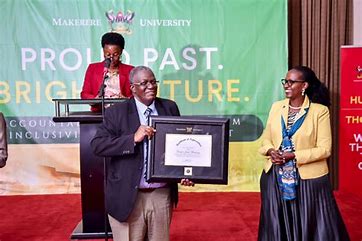
Most universities of the world are stuck in the realm of knowledge generation or adding, knowledge transfer and knowledge acquisition. Some have begun to let some of their knowledge workers engage in knowledge integration.
However, few universities have opened up to institutionalisation of knowledge integration. Even when they are made aware the knowledge integration movement has been around with us since the early 1970s, the majority prefer to continue as before: “disciplinary and multidisciplinary structure and function, producing specialists that are narrowly prepared for the 21st Century and beyond”.
Recently, Prof Robert Bakibinga, formally of the York College of Pennsylvania, USA confirmed that most universities, particularly in Africa, are structurally and functionally too rigid to open up to the evolving culture of knowledge integration. He decided to distribute, globally, a document titled The Struggle for Critical Thinking, Genuine Interaction, Sustainability and Future-Ready Professionals: An Unannoted Bibliography by Oweyegha-Afunaduula, Afunaduula Isaac and Mahir Balunywa of the Uganda-based Centre for Critical Thinking and Alternative Analysis (CCTAA).
Prof Bakibingawanted to find out the spread of awareness, resistance and receivability of the unannotated bibliography critical thinking, genuine interaction, sustainability, new professionalisms suitable for the 21st century of neoteric knowledge production through integration. Here under is the letter from Prof Robert Bakibinga to universities worldwide:
Dear Colleague,
Re: Unannotated – The struggle for critical thinking, genuine interaction, sustainability and future-ready professionals
I am happy to introduce to you the attached unannotated bibliography, so that you are aware it exists. “Higher education is changing so fast, especially with the advent of the Worldwide Web, which does not recognise the division of knowledge into small knowledge compartments, that universities cannot wait anymore to rethink how they do education. This document is an eye-opener. The writers have committed their time and energy to unravel how far humanity has gone to accommodate the new thinking about reintegration of knowledge”.
It is now possible to create new professions that allow scholars work in genuine teams and be relevant professionals for this century and beyond. Universities must be prepared once again to lead humanity into the future. I have no doubt that you, scholars and the academic fraternity, will find this document particularly timely and useful. Give it a thought…
Thanking you in advance,
Professor Robert Bakibinga, USA.
In a subsequent communication to the key author of the unannotated bibliography, Prof Robert Bakibinga wrote:
“This project of reaching out to universities to popularise knowledge reintegration is worthwhile. I think we need to continue with communicating and marketing it to the academic fraternity in institutions of higher learning worldwide, for consistency and faster global outreach.”
Preliminary assessment of the progress of the project revealed that:
- Most universities chose conspiracy of silence as their response
- Most universities are still unaware of knowledge integration in higher education.
- Academic leadership is firmly in the hands of the slow professors, so called because of their
rigid commitment to and protection of the disciplinary knowledge system
- The rethinking and reconstruction of global scholarship in view of new and different knowledge production has yet to find space in most universities
- An educated person remains a disciplinarily educated person, yet education is increasingly becoming integrated knowledge integration is a 21st Century imperative that has yet to be confronted by most universities Worldwide.
- The knowledge integration movement (KIM) that began in the early 1970s has not been institutionalised even in universities where a critical number of integrated and integrative scholars exist
- Many universities lack functional websites or emails and this could explain the very low awareness of, and receivability of knowledge integration in such institutions
- Universities that responded, evoked their disciplinarily determined stringent institutional barriers that had to be gone through or overcome before the document could be made available to their academics
- Most universities of the world in general and Africa in particular, are not anywhere near accommodating and participating in the new knowledge production strategies, or knowledge systems, of interdisciplinarity, crossdisciplinarity, transdisciplinary, extra-disciplinarity (non-disciplinarity), and thus KIM
Interdisciplinarity is a knowledge production strategy, system, culture or discourse that involves integrating knowledge and methods from different disciplines using a real synthesis of approaches. Crossdisciplinarity is a knowledge production strategy, system, culture or discourse that involves viewing one discipline from the perspective of another.
Transdisciplinarity is a knowledge production strategy, system, culture or discourse that involves creating a unity of intellectual frameworks beyond one discipline. Nondisciplinarity or extradisciplinarity is a knowledge production strategy, system, culture or discourse, which does not evoke or involve recourse to disciplines of knowledge. The term supradisciplinarity refers to the knowledge systems of interdisciplinarity, crossdisciplinarity and interdisciplinarity.
Although, as a strategy of resistance to new knowledge production systems, most universities of the world have accommodated multidisciplinarity (i.e., the bringing together of several disciplines in knowledge discourse) and pushed it as an integration strategy, it is not. The existence of extradisciplinarity and supradisciplinarity knowledge systems implies that there are many types of scholars and professionals the world is waiting for to tackle the complex or wicked problems that single disciplines, or even multiple ones, cannot solve. Such problems include environmental degradation, climate change, and globalization. However, as Professor Robert Bakibinga found out, most of present-day universities are unable to produce the new types of scholars for human and non-human world because, they are still deeply rooted and stuck in the “mud” of disciplinarity.
Robert Bakibinga found that the universities that were already receptive to knowledge integration and, therefore, familiar with the new knowledge production strategies or knowledge systems, of supradisciplinarity (ie, interdisciplinarity, crossdisciplinarity and transdisplinarity) and extradisciplinarity (ie, nondisciplinarity) were mostly in the USA, Western Europe, Canada, Australia, New Zealand and some countries of Asia such as Japan and China. Generally, unawareness of knowledge integration remains widespread in most of the universities of Eastern Europe, Latin America, Asia and Africa.
Robert Bakibinga confirmed that in Africa, Mbarara University of Science and Technology (MUST) in Uganda was amply aware of and receptive to knowledge integration. MUST had already institutionalised knowledge integration. In the early millennium it established, first an Institute of Interdisciplinary Studies and Research (IIS) and then a Faculty Interdisciplinary Studies and Research (FISR). The rest of African universities, including the newer ones, of the 21st century, are deeply mired in disciplinary scholarship and professionalism just as was the case in the 20th century universities. All their quality assurance mechanisms (QAM) are geared towards ensuring disciplinary academic standards of excellence, and a continuation with the sustenance of academic territories (natural science, social science and arts or humanities) as separate broad, disconnected knowledge fields, and the sustenance of academic tribes (disciplines).
It is for these reasons that our universities continue to be preoccupied with knowledge adding as opposed to knowledge integration. However, a few African scholars have been active in knowledge integration. They include Kofi Akamani, Robert Bakibinga (whose work necessitated the writing of this article), Machingura, Onyeka, Nyamwanza, Kakuho and Oweyegha-Afunaduula.
Let me distinguish between knowledge adding and knowledge integration:
Knowledge adding refers to the extent to which users add new content to knowledge sharing (Nan Wang, et.al, 2018). Knowledge integration is defined as “the recombination of knowledge by merging, categorizing, reclassifying, and synthesizing existing knowledge” (Majchrzak et al., 2013).
Although the factors influencing one specific knowledge contribution or knowledge-sharing behaviour (i.e, knowledge generation and adding) have been widely examined, the research on the factors that affect another type of knowledge contribution (i.e, knowledge integration), is still rare (e.g., Nan Wang, et al, 2018). This is explainable by the fact that most universities of the world have not been attracted to the practice of knowledge integration. Those universities that seem to be attracted have just a few academics trying to sell knowledge integration within the university body politic.
Therefore, most knowledge quality concerns are in disciplinary education’s knowledge adding, which is called “value-centric logic of knowledge contribution” (Nan Wang, et.al., 2018). Nan Wang, et.al. (2018) have proposed a value-justice model of knowledge integration to address the collaborative nature of this knowledge contribution. We now know that both perceived justice and value influence knowledge integration, which in turn affects knowledge quality. Knowledge equivocality strengthens the relationship between perceived justice and value, knowledge integration, and the relationship between knowledge integration and knowledge quality. We also know that collaborative knowledge integration can enhance knowledge quality and reduce the influence of knowledge equivocality.
The prior knowledge contribution or knowledge sharing studies have shed light on the underlying mechanisms that explain adding-type knowledge contribution behaviour. However, the theoretical understanding of knowledge integration is still underexplored (Arazy et al, 2011; Majchrzak et al (2013).
The prior knowledge contribution (knowledge adding in particular) research, following a value-centric logic, examines the impacts of a variety of value perceptions including extrinsic rewards, reputation or images, reciprocity, sense of self-worth, and enjoyment in helping others on knowledge contribution intention or behaviour (Bock et al, 2005; Sun et al., 2015).
In their study A Value – Justice Model of Knowledge Integration: The Moderating Role of Knowledge Equivocality, Nan Wang, et al (2018) considered knowledge integration to be a special type of knowledge contribution, as did Majchrzak et al 2013). They, however, asserted that there are still some differences between the adding-type knowledge contribution and knowledge integration, which calls for clarification by considering the unique features of knowledge integration (Nan Wang, et al, 2018).
Knowledge adding of one’s specialised domain knowledge to a knowledge repository will not lead to the modification of the knowledge contributed by others. However, if we go by what Yates, et al (2010) told us, knowledge integration involves the reorganisation, modification, and deletion of others’ contributions. So, knowledge-adding behaviour can be regarded as an independent behaviour that is only associated with an individual’s cognitive evaluations about his or her own behavioural consequences (i.e, self-interest) (Nan Wang, et al, 2018).
Knowledge integration is an interdependent behaviour that is related to the interests of both knowledge integrator and the users of knowledge whose contributed knowledge is modified (Majchrzak et al, 2013; Zhao et al, 2013). The interdependent nature of knowledge integration suggests that one knowledge integration action may cause the re-allocation of resources or benefits of stakeholders, and conflicts may occur during the benefit allocation process (Arazy et al, 2011, 2013, Nan Wang, et.al 2018).
This is why the justice theory, which is developed to explain disputes or conflict resolution (Kerwin et al, 2015; Kidwell et al, 2012; Richard et al., 2002) and captures the social comparison mechanism (Adams, 1963), complements the value-centric logic, and was considered by Nan Wang et.al. (2018).
Nan Wang, et.al. (2018) wanted to answer the question “Will perceived justice and perceived value jointly affect knowledge integration”
They agreed with Neill and Rose, 2007) that for different types of knowledge, the potential conflicts during the knowledge integration process may vary from one study to another. Therefore, the impacts of perceived justice and knowledge integration may be determined by knowledge features.
Daft and Lengel, 1986 and Lim & Benbasat, 2000 submitted that knowledge equivocality, which captures the extent to which the knowledge is unclear, uncertain, and/or ambiguous was selected by Nan Wang, et.al. (2018) as the construct given the positive relationship between equivocality/uncertainty and conflict (see Weber and Mayer, 2014 and Weingart et al., 2015).
Then Nan Wang, et.al. (2018) wanted to know if knowledge equivocality will moderate the relationships proposed in the value-justice model.
All in all, Nan Wang, et al (2018) highlighted in their study the interdependent nature of knowledge integration and proposed a value-justice model of knowledge integration beyond the value-centric logic to address this contextual feature. Second, they identified the boundary conditions under which the value-justice model works by investigating the moderating role of an important knowledge feature called knowledge equivocality.
There is no doubt, therefore, that knowledge integration has come to stay. It emphasizes interdependence (communalism) rather than independence (individualism) of scholars. It thus, devalues the value-centric logic, which is individualistic and independence stressing, and has dominated 20th century academicism and scholasticism, and values the value-justice model of knowledge culture, which stresses collaboration and, therefore, interdependence of scholars in the knowledge enterprise. Independence of scholars, however, continues to predominate. Most universities have academic policies that promote it even when the century of new and different knowledge production prefers interdependence of scholars, and therefore, integration of knowledge.
We can reaffirm, with confidence, that there is a knowledge integration movement (KIM), and that it is gaining currency as we advance towards the end of the first half of the 21st Century. A lot more of women scholars are the pillars of knowledge integration than and male scholars. They have been active in the knowledge integration enterprise. However, although we are in an increasingly diminishing global village, most work in knowledge integration enterprise continues to be concentrated in one part of the world, as Professor Robert Bakibinga found out, at the expense of the other, with Africa at the tail end.
We now have a sizeable and critical number of integrative and integrating scholars, but still lack a critical mass of integrative and integrating universities worldwide. The overwhelming majority are still stuck to “disintegrating” disciplinarity.
In this article I want to give a partial list of the men and women who have been active in knowledge integration. I will give their knowledge integration strategy of the new and different knowledge integration strategies (interdisciplinarity, crossdisciplinarity, trans-disciplinarity and extra-disciplinarity or non-disciplinarity).
These are also called the new cross-cultures of science education or the team of sciences. Extra-disciplinarity or non-disciplinarity is the most advanced knowledge integration strategy, and is the traditional knowledge system of humanity from time immemorial, only reduced in significance by extreme scholasticism and academicism in the modern university.
If we are to develop a thinking together mentality, reduce the influence of the slow professors, escape overspecialisation, rethink expertise and curtail recognition of academics without ethics in higher education, academic politics must change. It must favour individualism and ethnocentrisms far less and favour the merging of knowledge far more towards a more integrated academy and world.
Besides, it is by merging of knowledge through the new education, via the new knowledge production cultures of interdisciplinarity, crossdisciplinarity, trans-disciplinarity, and extra-disciplinarity that we can meaningfully and effectively tackle the wicked problems of the world such as environmental degradation and climate change.
The new edge of knowledge has been with us for some decades, and universities cannot afford to be left behind by KIM. We need a new academic man, Homo academicus, spread all over the world. This will be achieved if leadership in higher education is universally retuned to favour and promote new knowledge production away from knowledge adding. Unfortunately, as we have seen from the findings of Prof Robert Bakibinga, this is far from being the case.
The table below is a partial list of some knowledge integration workers worldwide since the early 1970s when Berger (1970), Apostel (1972), Apostel, et al (1972), Heckhausen (1972), Jantsch (1972) and Boisot (1972) started to advocate for interdisciplinarity, and Erich Jantsch (1972) started to advocate for both interdisciplinarity and trans-disciplinarity towards sustainable education and sustainability as a whole.
Enrich Jantsch saw integrating and integrative universities and the universities of the future, which is now. Unfortunately, as I have already mentioned higher education leaders were not listening and continue to ignore the message. Yet knowledge integration in integrating and integrated universities would make it much easier for humanity to achieve a more integrated world and make global and regional integration schemes a success story. Such schemes would be under the management and administration of products from the integration fields of knowledge.
Further research is definitely needed to establish which of the scholars listed below are women, men, still alive and active knowledge integration workers. Otherwise, the Table below shows each scholar and the integration strategy in which they are or were active. The category “General” refers to scholars involved in general theory of knowledge integration or who have applied the concept of integration in their work.
With the increasing importance of the World Wide Web, our global village is diminishing at a supersonic rate. This is weaving more and more scholars and other actors in increasingly integrated knowledge and intellectual communities. Extra-disciplinarity (non-disciplinarity) is becoming the knowledge imperative of the 21st century and beyond. Therefore, most scholars, who have been safe in their disciplinary cocoons, must begin to open up to working in academic and intellectual communities that have no respect for disciplinarity and that are more open to working in non-disciplinary teams that favour joint achievements, rewards and recognition than the current tendency to favour individual achievements, rewards and recognition.
Indeed, already it is becoming difficult for scholars that make individual achievements at the highest level of education. Those prepared as future ready professionals are now preferred by the World Wide Web dominated employment-world.
A cursory examination of the Table below reveals that while numerous scholars have been involved in knowledge integration in a general sense, the knowledge systems of interdisciplinarity and trans-disciplinarity have attracted a considerable number of scholars. There is need for more scholars to be active in the knowledge systems of Crossdisciplinarity and Extra-disciplinarity (non-disciplinarity).
- A Tell report / founder of Centre for Critical Thinking and Alternative Analysis (CCTAA)











